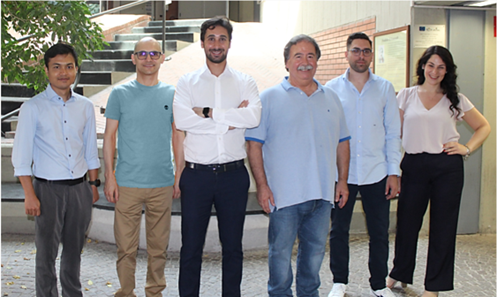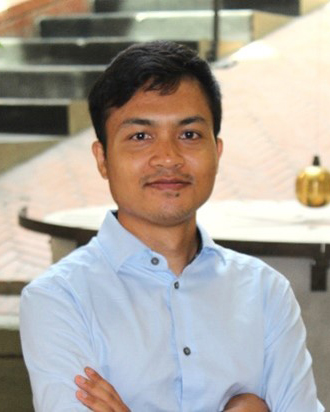
Stefano Oscurato and Komang Januariyasa have developed a groundbreaking technique that uses holographically structured light to mold three-dimensional azopolymer microstructures with unprecedented precision. Their work could impact everything from microrobotics to advanced optical devices.
Read ‘Molding three-dimensional azopolymer microstructures with holographically structured light’ in RSC Applied Interfaces, and learn more about this work in the interview below.
Could you introduce yourselves and the focus of your research group?
Stefano: Hi, I’m Stefano Oscurato, a researcher at the Physics Department, University of Naples, and I’m currently leading the Holographic Lithography research group.
Komang: Hi, I’m Komang. I’m a PhD candidate in the Physics Department, University of Naples, working with Stefano during my PhD program.
What are azopolymer materials, and what makes them unique for your research?
Stefano: Our group has been exploring the properties of a special class of photosensitive materials which are called azopolymers. The key element of these materials is that they can move under irradiation of light, and the motor of this movement is the azobenzene molecule which is embedded within the polymeric matrix. The movement depends both on the intensity and the polarization of light that we irradiate, making this phenomenon a possible new approach for the typography of structured surfaces.
Could you tell us more about the research behind your recent paper?
Komang: The idea of this experiment was to explore the potential of azopolymer to make complex yet controllable microstructures on the surfaces. To do that, we use an optical technique called computer-generated holography. This technique can generate any spatial intensity of light, and it’s fully computer-operated.
How did you prepare the pre-structured surfaces for this experiment?
Komang: In this experiment, we prepared pre-structured surfaces on our polymer using soft lithography. This soft lithography utilises a soft mold based on PDMS polymer, which has the negative pattern of the pre-structure that we want, and then we transfer that pattern to our polymer.
Can you provide a simple analogy to explain your method of molding these microstructures?
Stefano: To give you a simple analogy of our method, let’s imagine we are playing with some clay. The geometry of this clay can be molded in any three-dimensional shape by applying force at different positions. Here, we use the same concept but replace the clay with the azopolymer microstructure and our hands with structured light that applies force in different positions.
How does this allow you to create different architectures using only light?
Komang: In practice, we rationally design this pattern of light to generate different forces in different parts of the azopolymer micropillars and then eventually generate different kinds of architectures.
What are the potential future applications of your flexible method?
Stefano & Komang: Our method is very flexible and not limited just to three-dimensional reconfiguration of pre-structured surfaces. We are planning to use it in different fields, including wettability tuning, adhesion, but also photonics where the surface interacts with some additional light. For all of those applications, this strategy doesn’t stop here, since azopolymer can be manipulated by intensity of light but also with polarisation of light. In the future, we can offer a unique lithography strategies to make unconventional micropores on surfaces.
RSC Applied Interfaces delivers exactly what you need: breakthrough studies on surface and interfacial research with an applied focus. Every paper is here to bring you closer to your next discovery. Expand your knowledge and start reading.
Meet the authors

|
I Komang Januariyasa completed his Master’s degree in Physics at Universitas Gadjah Mada in 2019. Currently, he is finishing his Ph.D. program in Physics at the University of Naples “Federico II” and is expected to graduate in 2025. During the PhD program, he has been working on the strategy for the fabrication of functional surfaces using azopolymer and different optical strategies. |
 Stefano Luigi Oscurato Stefano Luigi Oscurato
Stefano Luigi Oscurato is Assistant Professor at the Physics department “Ettore Pancini”, University of Naples “Federico II” (Italy), since 2021. He received his PhD in Physics from University of Naples in 2018. His successive postdoctoral research fellowships involved research periods in Italy and USA, working on the development of optical techniques to investigate structural and optical properties of polymeric and nanostructured materials. Prof. Oscurato received the ERC Starting Grant in 2024 and is currently leading the Holographic Lithography research group, which focuses on the development of holo-photolithographic techniques for all-optical fabrication and tuning of reconfigurable flat diffractive components and functional structured surfaces. See LinkedIn profile here. |
 RSC Applied Interfaces is a dedicated, interdisciplinary reference journal for cutting-edge research on the applications of surfaces and interfaces. In addition to the applied focus, work considered for publication in RSC Applied Interfaces is expected to be highly original and of top quality. The journal seeks to report major scientific advances beyond the state of the art, at the cutting edge of this interdisciplinary field.
RSC Applied Interfaces is a dedicated, interdisciplinary reference journal for cutting-edge research on the applications of surfaces and interfaces. In addition to the applied focus, work considered for publication in RSC Applied Interfaces is expected to be highly original and of top quality. The journal seeks to report major scientific advances beyond the state of the art, at the cutting edge of this interdisciplinary field.


 I Komang Januariyasa
I Komang Januariyasa